One of the biggest disappointments of our recent trip to Paris was the inability to visit Picasso’s apartment studio where he lived and worked for almost twenty years including the entire four years of the German occupation. There are numerous photos of Picasso in the apartment and I was hoping to be able to present them to you along with contemporary images. Oh well—hopefully the building owners and the French government can work something out to allow visitors to the attic apartment (more on this later).
Despite an exodus of artists and gallery owners prior to the Germans entering Paris on 14 June 1940 and numerous offers to sponsor him in America, Pablo Picasso decided to remain in Paris. To this day, the real reason for why he stayed is unknown and can only be speculated.
There were three primary reasons why Picasso might have considered leaving France and conversely, reasons to be worried about his safety while remaining in Paris. First, the Nazis had declared his work to be “degenerate” art and eventually destroyed many of his paintings. Second, Picasso supported the Republican cause during the Spanish Civil War and as such, was an opponent of fascism and Hitler. Third, Picasso was suspected of being a Communist or at least having Communist sympathies. The one thing he did have in his favor was an international reputation that may have protected him. Learn more here.
Picasso was kept under constant surveillance during the occupation. German officers would visit him in his attic apartment−studio, and “hideout” at 7, rue des Grands Augustins (aka Grenier des Grands Augustins) in the Left Bank’s sixth district. Sometimes the Gestapo visits were to interrogate him. Other visits were by German officers wanting to meet and talk with the world-famous painter.
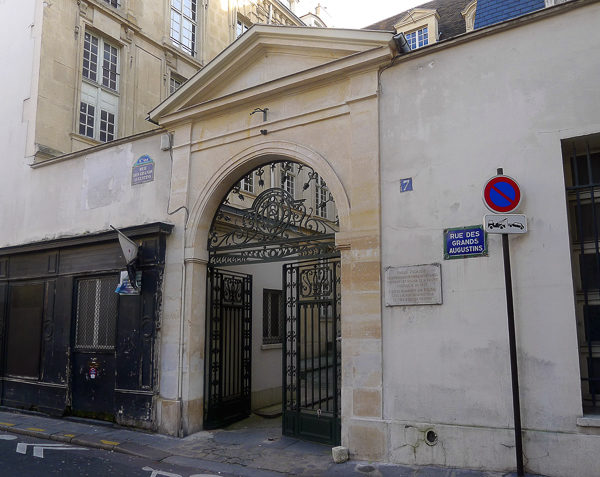
Let’s Meet Pablo Picasso
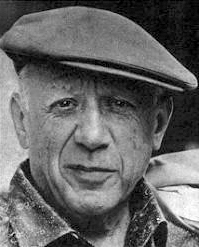
By the time of the German invasion of France, Pablo Picasso (1881−1973) was 59 years old, living in Paris, and already an internationally successful artist with a sizeable fortune. He was a Spanish citizen but living in exile due to his stand against fascism and the Franco regime (he would later apply, unsuccessfully, for French citizenship).
Picasso is known for his distinctive styles of painting. We are familiar with his artistic periods known as “Blue” (1901−1904), “Rose” (1904−1906), “African” (1907−1909), “Cubism” (1909−1912) as well as adventures with neoclassicism and surrealism. However, during the Occupation years, his work is relatively unknown. Most of it was kept by the family. The pieces known to the public are still life’s and portraits. For the most part, the art is dark and foreboding (as I’m sure he considered the times to be). As such, Picasso’s work from these four years doesn’t have the same appeal as earlier (or later) works.
Picasso visited Paris for the first time in 1900 at the age of nineteen. He met one of his best friends, Max Jacob, who taught Picasso to speak French (Jacob, a poet and journalist—and a Jew—would die at the Drancy detention center shortly before his scheduled deportation to Auschwitz). Between 1901 and 1904, Picasso traveled frequently between Paris and Spain. He settled permanently in Paris by 1904 and the next year, Picasso was “discovered” by Gertrude Stein and his work was collected by Gertrude and her two brothers, Leo and Michael.
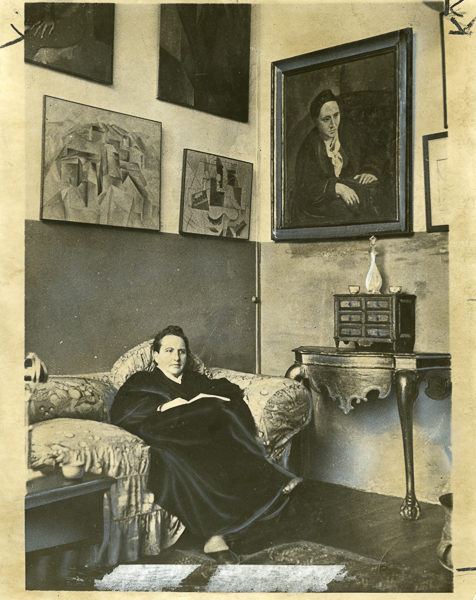
Shortly after his marriage to Olga Khokhlova in 1918, Picasso began an exclusive business relationship with the French-Jewish art dealer Paul Rosenberg (Rosenberg paid for Pablo and Olga’s apartment at 25, rue La Boétie—next door to his art gallery). It developed into a very deep bond between the two men and would last until Rosenberg fled Paris for the United States in the face of the pending Nazi invasion.
By 1927, Picasso had met and begun an affair with Marie-Thérèse Walter. This long-standing affair resulted in a daughter named Maya and a separation from his wife. Picasso and Olga never divorced and were legally married until Olga’s death in 1955. During the Occupation, Picasso’s mistress was his famous model, Dora Maar. After the liberation of Paris and up to his second marriage in 1961, Picasso would have numerous affairs with women many years younger than him. Four years after Picasso died, Marie-Thérèsa hanged herself having never accomplished her goal of marrying Picasso.
Guernica and the Spanish Civil War
Pablo Picasso was never considered a political artist. However, one of his greatest paintings dealt with the Spanish Civil War and the fight between the Republicans (supported by the Soviet Union) and General Francisco Franco (supported by Hitler and Mussolini).
Completed in 1937 (in the attic studio at Grenier des Grands Augustins), the painting called GUERNICA depicted Picasso’s interpretation of the bombing by the Nazis and Italians of a small Spanish town called Guernica. It is considered one of Picasso’s finest paintings. The painting resided at the Museum of Modern Art (MoMA) until 1981 when it was delivered back to Spain after Franco’s death as per Picasso’s request. Learn more here.
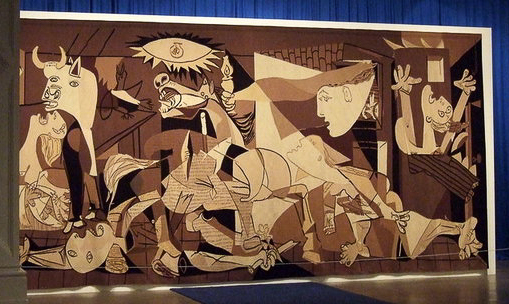
Watch the BBC video on GUERNICA. Picasso had a photo of the painting pinned to one of his walls in the attic studio. One day a Gestapo officer came to interrogate Picasso, saw the photo, and asked Picasso if he had done that. Picasso replied, “No, you did.”
Perhaps Picasso decided to remain in Paris as an act of defiance against the Germans? I guess it might be similar to how some Parisians decided an act of non-violent resistance was to turn their heads away from the Germans when passing on the street.
War and Politics
The painter deliberately kept a very low profile during the Occupation years. He knew his work was deemed by the Nazis to be “degenerate” and decided not to exhibit or offer any works for sale. Most of his social activities took place a short distance down the street at Le Catalan bistro (25, rue des Grands Augustins: no longer in existence). He rarely ventured beyond his little world.
There is some speculation that Picasso worked with the French Resistance (after the Liberation, he was hailed as a “Resistance artist”) but nothing exists to substantiate any type of cooperation. In fact, after the war, one of his friends and a Resistance member, Christian Zervos, stated that Picasso never got involved with the Resistance. Zervos stated, “Picasso simply kept his dignity during the Occupation the way millions of people did here.” However, Picasso had to have had some contact with the Resistance since he continued to sculpt in bronze. Recall my blog on the destruction of bronze statues. The Resistance may have supplied Picasso with the bronze.
Picasso was a pacifist. His life centered around his work, his friends, and his mistresses. While it would be naïve to think Picasso was apolitical, politics never really outwardly influenced him or his work—the notable exceptions being Guernica (1937), The Charnel House (1945), and a painting criticizing America’s involvement in Vietnam.
Soon after France was liberated (1944), Picasso joined the French Communist Party and remained a party member until his death. However, after the Soviets heavily criticized his 1953 portrait of Stalin, Picasso’s interest and involvement in the party waned. Even Picasso admitted, “… if I were a shoemaker, Royalist or Communist or anything else, I would not necessarily hammer my shoes in a special way to show my politics.”
Picasso’s Apartment-Studio Today
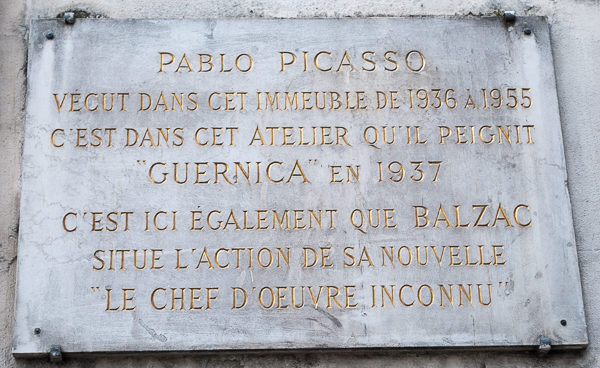
For decades, a discrete plaque has commemorated the site of Picasso’s former apartment and studio at the former 17th-century Hôtel de Savoie. The building has been owned by the Chambre des Huissiers de Justice (Chamber of Legal Bailiffs) since 1925. It leased the space to a private cultural organization, the Comité national pour l’éducation artistique (CNEA) for the purpose of holding exhibitions and workshops. Unfortunately, the rent-free lease expired in 2013 and the owner evicted the CNEA. The plan was to renovate and turn the building into a luxury hotel.
After the CNEA petitioned the city and French government, the top two floors were designated a historical monument in May 2014 (i.e., a national landmark). The building owner would now be subjected to a costly and time-consuming redevelopment. Picasso’s daughter, Maya Widmaier-Picasso, became involved in the negotiations with the owner and by 2015, an agreement had been reached.
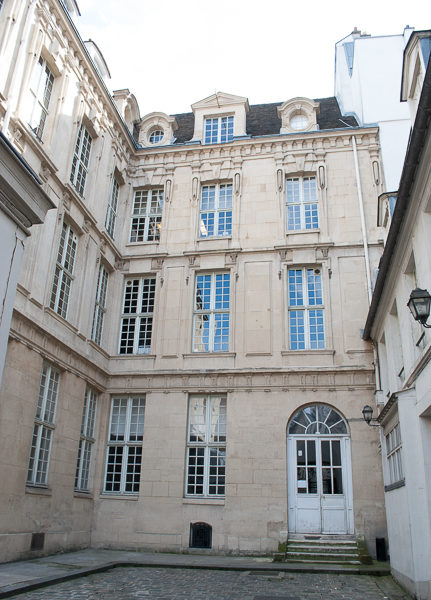
Maya’s foundation would manage the ground floor as space dedicated to “the life and work of the artist, and for research projects.” The owner would establish “a versatile venue hotel that relates to the work of Pablo Picasso.” So, in the end, it “will house a commercial hotel, artist residencies, cultural hub, and historic monument.”
I guess allowing the general public in to see the attic and studio got lost in the shuffle. Too bad.
Recommended Reading
Irvine, Zoe (Laura). Painting the War: Picasso’s Genre Works During the German Occupation of Paris. History of Art Senior Thesis (2005).
Riding, Alan. And the Show Went On. New York: Vintage Books, 2011.
Nicholas, Lynn H. The Rape of Europa. New York: Vintage Books, 1995.
Goggin, Mary Margaret. Picasso and His Art During the German Occupation 1939−1944. Stanford University PhD. 1985, University Microfilms International, Ann Arbor, Michigan.
Paris Revolutionnaire: This is an exhaustive list of sites in and around Paris that were significant to Picasso’s career and personal life. It is in French so make sure you have your French-English dictionary handy. Click here.
What’s New With Sandy and Stew?
The next two blogs (25 November and 9 December) are a result of our visit several weeks ago to Nuremburg, Germany. We visited the Zeppelin Field where the major Nazi rallies were conducted between 1927 and 1939. Then we were taken to the courtroom where the post-war Nuremburg trials were conducted. It’s hit or miss as to whether Room 600 will be open to visitors (it is still used as a working court room). We were lucky.
What I realized after our visit that day was that these two particular sites represented the bookends to National Socialism (i.e., the Nazi party): the beginning and the end. I hope you enjoy reading the next two blogs.
Someone Is Commenting On Our Blogs
If there is a topic you’d like to see a blog written about, please don’t hesitate to contact me. I love hearing from you so keep those comments coming. Please tell your friends about our blog site and encourage them to visit and subscribe. Sandy and I are trying to increase our audience and we need your help through your friends and social media followers.
Why Would You Want To Buy Our “Walks Through History” Books?
Simple.
You like to travel and experience history and historical events. You like to see original buildings that had a significant impact on the people and events of the history you’re engaged with. You want to know the stories behind the brick and mortar in front of you. The walking tour books are meticulously researched so you can go directly to those sites and learn about the building’s history as well as an introduction to some of the more interesting people associated with it.
Thank You
Sandy and I appreciate you visiting with us. We have some exciting things on the horizon and we’ll keep you updated as we go along.
Share This:
Follow Stew:
Find Stew’s books on Amazon and iBooks.
Please note that we do not and will not take compensation from individuals or companies mentioned or promoted in the blogs.
Walks Through History
Copyright © 2017 Stew Ross


I do no know how old the blog is, or whether you have visited Rouen. Opposite the Cathedral is a realistic historic film account of the trial and committal of Joan of Arc, in the very preserved house in which she was questioned, tried and condemned. It is a great experience, although biased. for she was really condemned on the grounds of blasphemy .
Hi Archie,
Thanks for reaching out to us. We always enjoy hearing from our readers. Sandy and I traveled to Rouen years ago and visited the only section that remains of the old city wall. Part of it is the tower where supposedly, Joan of Arc was imprisoned and “interrogated.” I didn’t know about the preserved house you speak of. Be assured that the next time we’re in Rouen, we will find the house and visit it. If you have any pictures, please send them to me.
In 1573 this n7 rue saints augustins was property of antoine duprat, prevot of city of Paris from 1553 to 1592. He was grandson of François 1st chancellor.
There’s a story related to that hotel, in 1573 duc of Anjou (futere king henri lll of france) became king of poland. He had a mistress, blonde Renee de Rieux, called “la belle Chateauneuf ” so he decided to find her a good husband and he made a proposal to Antoine Duprat, but Duprat didnt want to marry her. So prince’s vengeance was to make antoine duprat invite him and his brother king Charles lX and their cousin king of Navarre (future king Henri IV of france), of course nobody would refuse the honor of receiving three kings, so duprat had to spend huge amount of money on preparation. But when the royal guests left they took with them all the silver dishes and a coffer with 50 000 livres)))) and who would be brave enough to call the king a thief? Sorry for my english but i thought this story must be here. Paris has much deeper history than nazis or picasso.
Hello Camille;
Thank you for your comments. First of all, I am confident that your command of English is far greater than my ability to speak or write in your native language. I appreciate the story about past residents of the building. Every building in Paris has multiple stories about its history and those who resided in it. I agree with you about the history of Paris being far more than about Picasso and the Nazis. This is why I decided to write the series on Paris focusing on various historical events (e.g., French Revolution and the Nazi Occupation) as well as different historical periods (e.g., Medieval Paris). As you go back into the blogs I’ve posted over the past five years, you’ll likely notice that I tend to write about subjects which pertain to the next book. So, for the past year or so, I’ve tended to concentrate on the Nazi occupation and the peripheral stories associated with those four years. I hope you’ll visit some of the previous blogs which delve into different periods of Paris history. Again, thank you for reaching out to us and I hope you’ll become a regular subscriber to our bi-weekly blogs. STEW